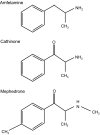Clinical characteristics of mephedrone toxicity reported to the U.K. National Poisons Information Service
- PMID: 20798084
- PMCID: PMC3143586
- DOI: 10.1136/emj.2010.096636
Clinical characteristics of mephedrone toxicity reported to the U.K. National Poisons Information Service
Abstract
Objective: To describe the patterns and clinical features of toxicity related to recreational use of mephedrone and other cathinones in the U.K. using data collected by the National Poisons Information Service (NPIS).
Methods: The number of accesses to TOXBASE, the NPIS online poisons information database, details of consecutive cases uploaded onto TOXBASE and the number and details of telephone enquiries made to the NPIS by health professionals in the U.K. were collected for the period March 2009 to February 2010.
Results: Over the year of study there were 2901 TOXBASE accesses and 188 telephone enquiries relating to cathinones, the majority relating to mephedrone (TOXBASE 1664, telephone 157), with a month-on-month increase in numbers. In 131 telephone enquiries concerning mephedrone, alone or in combination with alcohol, common clinical features reported included agitation or aggression (n=32, 24%, 95% CI 18% to 33%), tachycardia (n=29, 22%, 95% CI 16% to 30%), confusion or psychosis (n=18, 14%, 95% CI 9% to 21%), chest pain (n=17, 13%, 95% CI 8% to 20%), nausea (n=15, 11%, 95% CI 7% to 18%), palpitations (n=14, 11%, 95% CI 6% to 18%), peripheral vasoconstriction (n=10, 8%, 95% CI 4% to 14%) and headache (n=7, 5%, 95% CI 2% to 11%). Convulsions were reported in four cases (3%, 95% CI 1% to 8%). One exposed person died following cardiac arrest (1%, 95% CI 0% to 4%), although subsequent investigation suggested that mephedrone was not responsible.
Conclusions: Toxicity associated with recreational mephedrone use is increasingly common in the UK. Sympathomimetic adverse effects are common and severe effects are also reported. Structured data collected by the NPIS may be of use in identifying trends in poisoning and in establishing toxidromes for new drugs of abuse.
Conflict of interest statement
Figures
References
-
- Advisory Council on the Misuse of Drugs Consideration of the cathinones. 31 March 2010. http://drugs.homeoffice.gov.uk/publication-search/acmd/ACMD-cathinones-r... (accessed 1 Apr 2010).
-
- Winstock AR, Marsden J, Mitcheson L. What should be done about mephedrone? BMJ 2010;340:c1605. - PubMed
-
- Kamata HT, Shima N, Zaitsu K, et al. Metabolism of the recently encountered designer drug, methylone, in humans and rats. Xenobiotica 2006;36:709–23 - PubMed
-
- Markus R, Meyer MR, Wilhelm J, et al. Beta-keto amphetamines: studies on the metabolism of the designer drug mephedrone and toxicological detection of mephedrone, butylone, and methylone in urine using gas chromatography–mass spectrometry. Anal Bioanal Chem 2010;397:1225–33 - PubMed
-
- Glennon RA, Yousif MY, Naiman N, et al. Methcathinone: a new and potent amphetamine-like agent. Pharmacol Biochem Behav 1987;26:547–51 - PubMed


